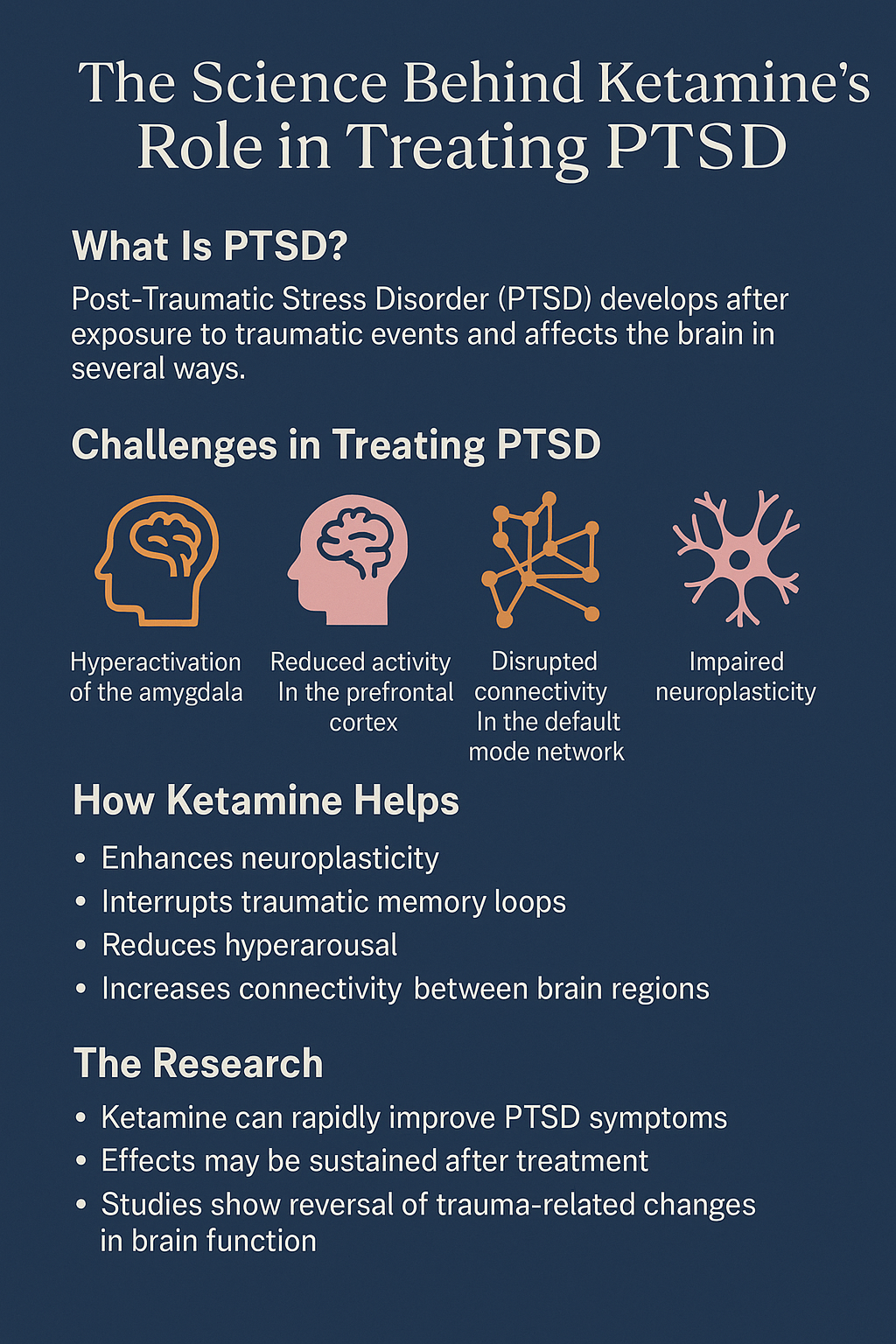The Science Behind Ketamine’s Role in Treating PTSD
Post-Traumatic Stress Disorder (PTSD) is one of the most complex and difficult mental health conditions to treat. Affecting veterans, first responders, survivors of abuse, and many others, PTSD can disrupt daily life through flashbacks, insomnia, emotional numbness, and intense anxiety.
While traditional treatments like talk therapy and SSRIs can help some, many people find only limited relief. That’s where ketamine therapy comes in—offering new hope based on a growing body of compelling scientific research.
What Is PTSD—and Why Is It So Hard to Treat?
PTSD develops after exposure to traumatic events, and it affects the brain in profound ways. People with PTSD often experience:
Hyperactivation of the amygdala, the brain’s fear center
Reduced activity in the prefrontal cortex, which governs rational thought
Disrupted connectivity in the default mode network, tied to self-awareness and rumination
Impaired neuroplasticity, limiting the brain’s ability to recover
Conventional treatments typically aim to regulate neurotransmitters like serotonin or manage symptoms over time. But they don’t always address the deeper neurological damage caused by trauma.
How Ketamine Changes the Game
Ketamine takes a completely different approach. It targets the glutamate system, stimulating the growth of new neural pathways and helping the brain reconnect in healthier, more adaptive ways.
Here's how ketamine helps treat PTSD:
Enhances neuroplasticity – promoting new connections and recovery
Interrupts traumatic memory loops – allowing the brain to process without re-experiencing
Reduces hyperarousal – calming the fight-or-flight response
Increases connectivity between brain regions involved in memory, emotion, and self-regulation
Within hours of administration, many patients report feeling lighter, calmer, and more emotionally present.
The Research: Promising and Growing
Several studies have shown that ketamine can produce rapid and sustained improvements in PTSD symptoms:
A 2021 trial published in The American Journal of Psychiatry found that repeated ketamine infusions significantly reduced PTSD symptoms compared to placebo.
Another study by the Mount Sinai School of Medicine demonstrated that ketamine improved both PTSD and comorbid depression—often present together.
Functional MRI scans have shown ketamine reversing trauma-related changes in brain function.
These results are particularly hopeful for individuals who have not responded to other treatments.
Why Ketamine Works When Other Treatments Don't
Traditional medications for PTSD (such as SSRIs) can take weeks or months to show results, and they often come with side effects like emotional numbing or insomnia. Ketamine works within hours and doesn’t blunt your emotional range.
Unlike talk therapy alone, ketamine helps the brain reach a more receptive, flexible state—opening the door for healing and integration.
What Treatment Looks Like at Well3
At Well3, ketamine therapy for PTSD is delivered in a supportive, structured environment. Clients receive:
Personalized dosing and treatment plans
Pre- and post-session coaching for integration
Safe, guided sessions with licensed professionals
Supportive follow-up to maintain progress and prevent relapse
Hope Is Possible
If you or someone you care about is living with the burden of trauma, it’s important to know: recovery is possible. Ketamine therapy is not a magic cure—but for many, it’s the catalyst for a life no longer ruled by fear.
Want to explore ketamine therapy for PTSD?
Learn more and book a free consultation at www.well3.care.
#PTSDRecovery #KetamineTherapy #TraumaHealing #MentalHealthSupport #Neuroplasticity #KetamineForPTSD #RapidRelief #ModernTherapy #Well3Care #BreakTheCycle

